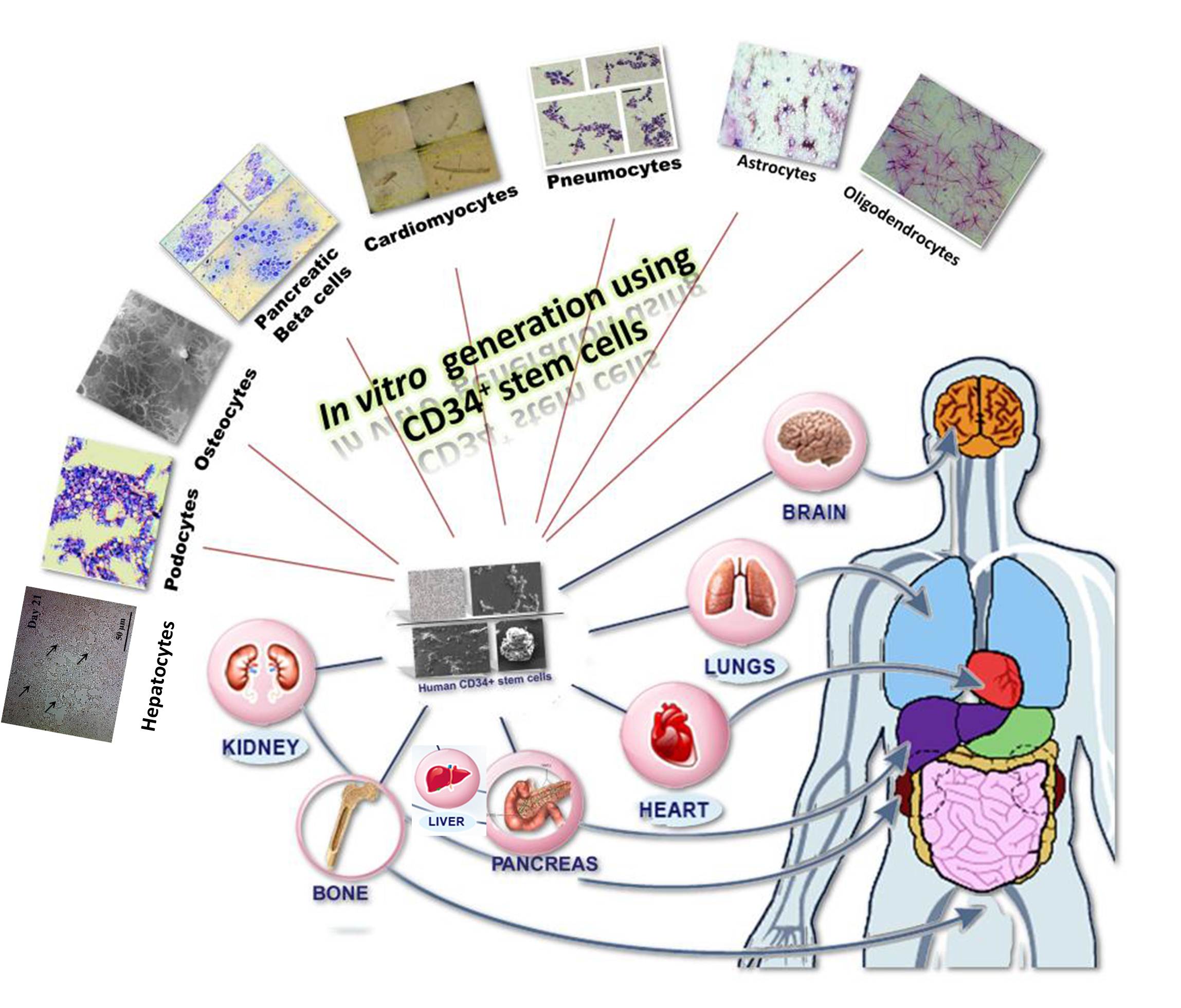Contributions
Human Haematopoietic stem cell Laboratory

In
vitro
differentiations of cultured Human Haematopoietic stem cells into
different cell lineages

Stem cell therapy offers a great potential in the treatment of
several diseases and it becomes an attractive basis for cell-based
regenerative therapies. Haematopoietic stem cells (HSCs) are
characterized by the presence of CD34+ and CD 133+ cell surface
proteins; they inhabit in bone marrow. In our department human CD34+
cells were isolated from peripheral blood of a donor was mobilized
with G-CSF (5µg/kg/day) using AsTech cell separator fitted with Rvy
kit. Thus isolated CD34+ cells through Apheresis technique were
evaluated by Immuno histochemical, immunoblot and FACS techniques.
These pure cells were cultured in DMEM containing 10% FBS, 5% CO2
at 37°C and with 95% humidity. With the help of
growth factors and other lineage specific factors we were able to
differentiate these human HSCs into cardiomyocytes, astrocytes,
oligodendrocytes, type II pneumocytes, osteocytes, podocytes, Beta
cells of islets of langerhans, hepatocytes, erythrocytes,
megakaryocytes leading to functional platelets, indicating that
human haematopoietic stem cells have the ability to form any type
cells of human body. In this process developing different lineages
from HSCs novel methodologies for differentiation were developed in
the department and of them two methodologies have been submitted for
obtaining patents (1. Indian patent filed: TR-5 CBR No.
13582/E-2/1374/2019-CHE. Application number: 201941016975. 2. Indian
patent filed: TR-5 CBR No. 13583/E-2/1375/2019-CHE. Application
number: 201941016976). Autologous transplantation of these HSCs
could be the best option to regenerate the damaged tissues and
organs. Standardizing such lineages differentiated from HSCs became
very useful in understanding in the pathophysiology of diseases
involving these differentiated cells. For example, endongeneous
erythroid colony formation assay (CFU-E assay) is used to understand
the formation of erythrocytes from HSCs. This has become very
important parameter in the diagnosis of erythrocytosis.

DNA and RNA isolations, PCR, qPCR and mutational analysis of various
diseases
Medical genetics is any application of genetic principles to medical
practice. This includes studies of inheritance, mapping disease
genes, diagnosis and treatment, and genetic counselling. We are
actively involved in the genetic analysis of various genes involved
or implicated in different diseases and assisting our faculty of
various departments in getting information in this regard. In this
process we have identified several novel alleles in several genes
which are implicated in the progression of the disease or in the
diagnosis of the disease. Some of the important genes in which novel
mutations were identified are:
Polycystic kidney disease 1 (PKD1), Angiotensin I converting enzyme
(ACE), Von Hippel- Lindau tumor suppressor (VHL), Wilm’s tumor 1
(WT1), Complement Factor H (CFH), Proline-serine-threonine
phosphatase-interacting protein 1 (PSTPIP1/CD2BP1), ATPase V-type
subunit B1 (ATP6V1B1), Glucokinase (GCK), BRCA1, BRCA2, MGMT, NF-2,
AKT, NPHS1, BCR-abl , mbCOMT, EPO-R, EPASI, EGLN1 and VHL genes
Recently, we have identified novel alleles in the kinase domain of
BCR-abl gene which was contributing in the imatinib resistance in
CML patients. This study was undertaken in collaboration with
Department of Haematology. Further, causative reason for
erythrocytosis (both Polycythemia vera and congenital erythrocytosis)
have been answered through genetic analysis of JAK2 (exons 12 and
14), EPASI, EPO-R and VHL genes wherein we have identified reported
and novel alleles respectively, this study is also carried with
active cooperation of Department of Haematology.



BCR-ABL novel alleles
mbCOMT gene novel alleles
Microbial Genetics Laboratory

Development of novel drugs against Staphylococcus aureus

Staphylococcus aureus is
a common inhabitant of human nasopharynx. It is also a cause of
life-threatening illness, producing a potent array of virulence
factors that enable survival in normally sterile sites. The
transformation of S. aureus from commensal to pathogen is
poorly understood. Up-regulation of virulence factors aids in mature
biofilm formation which is metabolically regulated the expressions
of IDH, LDH, PK, NADK, IMPDH, SDH and STPK regulates the redox
status in the pathogen paving way for the expression of virulence
factors and mature biofilm formation which are the key pathogenic
factors of S. aureus. In house enzyme assays and biofilm
tests were developed to understand the involvement of metabolism in
the expression of virulence factors and biofilm formation. In this
process spectrophotometric analysis of STPK and BYK were developed
and this unique process has been patented (Indian Patent filed:
TR-5. C.B.R. NO: 6535).
Occurrence of multidrug resistance strains of S. aureus has
complicated the treatment and management of S. aureus
infections and new drug targets which are pathogen specific is the
need of the hour. In this perspective we have developed MMOXC
(4-methoxy-1-methyl-2-oxopyridine-3-carbamide) a derivative of
ricinine MMOXC and a novel Dibenzyl (benzo[d]
thiazol-2-yl(hydroxy)methyl) phosphonate (3b) derived from α-Hydroxyphosphonate
which exhibited prominent anti-S. aureus and anti-biofilm
properties by blocking cell wall formation, RNA biosynthesis and
protein maturation.
